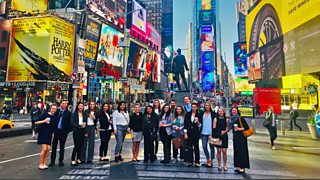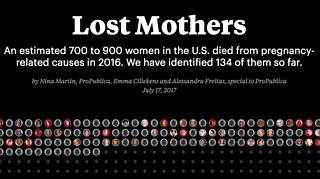New York City: Still spreading the news
Damian Radcliffe
is professor of journalism, Univ of Oregon @damianradcliffe
Each year, my colleague and I take a group of students to visit news and media organisations in New York City, diving headlong into the hottest issues being debated across the industry.

University of Oregon students in Times Square
After 18 meetings in a busy week, here are three key themes that emerged from our recent trip:
1. Traditional players are shaking things up
“Fortune favours the brave” may sound like an MBA cliché, but this notion was very much in evidence at traditional media organisations like Condé Nast, NBC, Hearst and Reuters.
Reuters (established 1851) has come a from the days of delivering stock prices by carrier pigeon. Like a number of publishers, they’re experimenting with providing “flash briefings” on voice controlled digital assistants like Amazon Echo and Google Home. They get 17,000 listens per minute on their , Dan Colarusso, an executive editor for Reuters TV told us.

What website do you think gets the biggest traffic for , a stable which includes Good Housekeeping, Cosmopolitan, Men’s Health and Marie Claire? The answer is - a digital only product - which covers food news, recipes and features for “the home cook.” There’s no print edition to support Delish: instead, the focus in on digital partnerships (such as a ) and distribution via its website and major social media networks.
At the time of writing, a video about has had seven million views on Facebook alone in the week since it was published.

Finally, with , a digital video outlet deliberately based several miles from the corporate HQ (mimicking an approach taken by Qatar based broadcaster Al Jazeera a few years ago when they launched AJ+ out of San Francisco), it’s clear that many of New York’s older media entities are actively embracing opportunities to get into new editorial, digital and physical, spaces.
2. There are over 300 ethnic and cooperative media outlets in the city
“Combined circulation of daily and weekly community and ethnic publications reaches 4.5 million people - more than half of New York City’s population,” the Mayor’s office has .
More than 200 languages are spoken in the city and around two in five of the population are immigrants. Almost two million of New York’s 8.5 million people speak languages other than English. It’s against this backdrop that community media plays an often overlooked role.
In 2016, the Mayor’s office a $1 million grant to the sector, to help community media embrace digital skills and business models. Outlets like - a Chinese daily founded in 1976 and distributed nationwide, are by publishing materials such as Brooklyn Weekly, a Chinese business directory and bilingual medical manuals.
This vibrancy contrasts with in the city, but the sector is not immune to changing market forces. As the co-directors of the Karen Pennar and Jehangir Khattak told us, there used to be four Bangladeshi papers; now there are 17. But where these used to be sold at Bangladeshi stores, they’re now offered for free.
Competition, the willingness of audiences to pay for news content and the need to reach younger audiences: these are issues in all sectors of the media.
3. Great journalism continues to have an impact
At the cutting edge of news delivery, offers an algorithmically generated experience for TV viewers, with audiences able to select the length of the bulletin they want to watch. Bulletins range from five to 30 minutes, with each bulletin covering the same stories, yet offering “a different version of each story and how deep you want to go.”
With a reach of up to four million people, average engagement on Apple TV and Roku Smart TVs is 22 minutes, we were told. On mobile it’s about 12 minutes. These numbers reflect Reuters’ ability to offer audiences an impartial video product which Dan Colarusso, described, as “global news, seriously told.”
Equally serious, though more traditional in format, the city’s ethnic media often cover stories not found elsewhere. A 2014 ( in Korean) about elderly Koreans being kicked out by the police of a McDonald’s in Flushing was later by the New York Times, as was a on the toxic chemicals used by workers in the city’s nail bars.

ProPublica's Lost Mothers investigation
The non-profit ProPublica won two Pulitzers this year (). Its incredible series on maternal mortality in the U.S. - - has not only receiving considerable recognition, but the series - co-produced with NPR - is changing the conversation.
As ProPublica last month:
“Citing Lost Mothers, state and local lawmakers around the country have adopted a flurry of bills aimed at reforming how maternal deaths are identified and investigated. Indiana and Oregon passed laws creating maternal mortality review committees to scrutinize deaths and near-deaths among expectant and new mothers, and to make policy recommendations to improve maternal health. Similar bills are pending in Washington, D.C., Pennsylvania, Connecticut, Maryland and New Jersey.”
And on the last day of our week’s programme, a visit to BuzzFeed News highlighted how by meant that the Boston Marathon had its decision not to award prize money to a number of women runners.
Journalism in New York, as elsewhere, is not without its challenges. But it’s also an incredibly vibrant field, full of great people with big ideas delivering impactful work. For our students, hearing about it gave them confidence that journalism remains a profession they can commit to for the long-haul.
